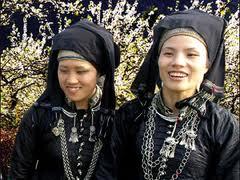The majority of the Nung immigrated to Vietnam 2 or 3 centuries ago from Quang Tay, China.
Proper name: Nong
Population: 705,709 people
Local groups: Nung Giang, Nung Xuong, Nung An, Nung Inh, Nung Loi, Nung Chao, Nung Phan Sling, Nung Quy Rin, Nung Din…
Language: The Nung language belongs to the Tay-Thai language group (Tai-Kadai language family), and is in the same group with the Tay, Thai, and Choang of China.
History: The majority of the Nung immigrated to Vietnam 2 or 3 centuries ago from Quang Tay, China.
Production activities
The Nung are excellent at cultivating fields. Although, because they survive places where wet fields cannot be exploited, they need to figure on terraced fields instead. Beside corn and rice, the Nung additionally plant another root vegetables, calabashes, and inexperienced vegetables.
The Nung know how to create several handicraft merchandise from weaving, metal operating, poonah-paper creating, and tile creating. Although several of these handicrafts are family traditions, they're still secondary professions, and done throughout spare time when there's an opening from farming. Furthermore, handicraft merchandise serve mainly family wants. Today, a number of them are diminishing (weaving), and a few are preserved and highly developed (metal working). In Phuc Xen village (Quang Hoa, Cao Bang), several families apply blacksmithing, and there's a minimum of one person in every family is aware of a way to hammer well.
Nung markets are highly developed. They go to fairs to trade, sell, and buy product. Kids, particularly the Nung Phan Slinh group, wish to head to fairs and sing love duets
Diet: In several regions, the Nung eat mainly corn. Corn is ground into flour to create thick soup. Foods are fried, stir-fried, or well-cooked, however seldom boiled. Many people don’t eat water buffalo, beef, or dog meat.
Clothing: The Nung’s ancient garments are fairly easy, and are typically made of rough, handmade, self-dyed materials, and have virtually no embroidery or decorations. Men wear shirts with standing collars that have cloth buttons. Women wear long shirts with five panels, buttoned up beneath the proper arm

Housing: the Nung live within the northeast of the country, and blend in at the side of the Tay. They keep largely in stilt homes. Some live in earthen homes built with paper or brick walls. In the past, on the border, there were houses built like a fort with blockhouses and loopholes to forestall and protect robbers.
Transportation: Ancient ways of transportation are carrying products in the arms, on the shoulders, and using shoulder poles. In some places these days, the Nung use carriages with ties or runners, which are pulled by animals as a mean of transportation
Social organization: Before August Revolution, Nung society had developed as much as the Tay’s. Fields and terraces had become personal possessions, and therefore can be transferred or sold. 2 social categories were formed: landlords and tenants
Marriage: Young Nung men and women are unengaged to date and to love. While dating, they typically provide gifts to every different. A young man could provide his girl a shoulder pole, a basket for storing cotton (hap li), a basket for storing thread (com lot). In return, a girl may provide her young man a shirt and an embroidered bag. It's the parents, however, who decide if a few will marry one another. They have to ascertain if the 2 families are of constant social rank, and if the fates of the 2 kids match along. The bride’s family typically demands gifts or meat, rice, wine, and a few cash. The additional the gifts are, the upper the girl’s price is alleged to be. Wedding should undergo several steps, and the most vital one is the ceremony to bring the bride to the groom’s family. After the marriage, the wife still stays together with her circle of relatives till she is getting ready to provide birth, then she is going to move to her husband’s house
Funerals: There are several rituals with the key goal: to bring the dead person’s spirit to subsequent world
New house: Building a replacement home is one in all the Nung’s most vital tasks. Therefore, when it happens, the Nung pay close attention in selecting the land, the direction, the day to maneuver in. They do all of those steps rigorously in hopes that within the new house, they're going to have a prosperous life.
Beliefs: The Nung mainly worship their ancestors. The altar is placed within the house, and is nicely adorned. In the center of the altar may be a monument (phung slan) written in Chinese that records the origin of a family. Additionally, the Nung additionally worship theland God, the Buddhist Goddess of Mercy, Midwife, door’s ghost (phi suspend chan), etc. They hold worshipping rituals when there's natural disaster, or disease plague. In distinction to the Tay, the Nung celebrate the birthday, not the anniversary of an individual’s death.
Festivals: The Nung celebrate lunar New Year like the Vietnamese and the Tay
Calendar: The Nung use the lunar calendar
Education: The Nung use a script based on Chinese characters, and browse in Nung and Tay-Nung language, that is predicated on the Latin script
Artistic activities: Sli is love duet for young men and ladies to sing in teams. Often, 2 boys sing with 2 ladies. They sing sli along on holidays and festival occasions, at a fair, or perhaps on trains, cars
Entertainment: For festivals and holidays, there are games like throwing shuttlecock, badminton, spinning prime, and tug of war, etc.
Source: wil-travel
Vietnam guide, Vietnam travel guide
Population: 705,709 people
Local groups: Nung Giang, Nung Xuong, Nung An, Nung Inh, Nung Loi, Nung Chao, Nung Phan Sling, Nung Quy Rin, Nung Din…
Language: The Nung language belongs to the Tay-Thai language cluster (Tai-Kadai language family), and is within the same cluster with the Tay, Thai, and Choang of China
History: the bulk of the Nung immigrated to Vietnam 2 or 3 centuries ago from Quang Tay, China

 bởi
bởi 

